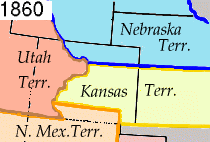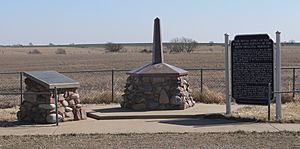Kansas Territory facts for kids
The Territory of Kansas was a part of the United States that existed from May 30, 1854, until January 29, 1861. On that date, the eastern part of the territory became the state of Kansas.
The Kansas Territory stretched from the border of Missouri in the east all the way to the top of the Rocky Mountains in the west. From north to south, it ran between the 37th and 40th parallel lines of latitude. A large part of what is now the State of Colorado was once part of the Kansas Territory. The western part of the old Kansas Territory became the Colorado Territory on February 28, 1861.
Contents
The Kansas–Nebraska Act
The Kansas Territory was created by a law called the Kansas–Nebraska Act. This Act became law on May 30, 1854. It also created the Nebraska Territory.
This new law changed an older one called the Missouri Compromise of 1820. The Missouri Compromise had drawn a line across the country, saying that states north of the line would be "free states" (where slavery was not allowed), and states south of the line could be "slave states" (where slavery was allowed).
The Kansas-Nebraska Act changed this. It said that the people living in the Kansas Territory could decide for themselves whether Kansas would allow slavery or not. This idea was called "popular sovereignty," meaning the people had the power to choose.
The Act had many parts. Some important parts for Kansas Territory were:
- It set the borders of Kansas and said that when it became a state, it could choose to allow slavery or not. It also protected the rights of Native American tribes living there.
- It made sure that the Fugitive Slave Act of 1850 was still in effect in the territory. This law said that escaped slaves had to be returned to their owners.
- It set the first temporary government center at Fort Leavenworth.
- It confirmed that all agreements the U.S. Government had made with Native American tribes in the territory would remain valid.
Settlers Arrive in Kansas
After the Kansas–Nebraska Act was passed, many people moved into the Kansas Territory. They came from different places and had different ideas about slavery.
Pro-Slavery Settlers
Within days of the Act becoming law, hundreds of people from Missouri crossed into Kansas. These people were often called "Border Ruffians." Many of them quickly claimed land and tried to vote in meetings to make Kansas a slave state. They wanted to show that most people in the area supported slavery.
These Missourians even said in newspapers that they would fight to make Kansas a slave state. They warned people who were against slavery not to settle in Kansas Territory south of a certain line.
Free-Staters
Even before the Kansas-Nebraska Act was passed, groups were planning for people from "free states" to move to Kansas. The biggest group was the New England Emigrant Aid Company.
People from free states like New England, Iowa, and Ohio started moving into Kansas in 1854. These settlers were known as "Free-Staters." They wanted Kansas to be a free state. Because the Missourians had claimed much of the land near the border, the Free-Staters often settled further inside Kansas Territory. They founded towns like Lawrence, Topeka, and Manhattan.
Abolitionists
Abolitionists were like Free-Staters because they did not want Kansas to become a slave state. However, Abolitionists wanted to end slavery everywhere in the United States. They also believed that all people, including Black people, should have equal rights.
Many Free-Staters, on the other hand, mainly wanted Kansas to be a place for white people only, without slavery. They often held prejudiced views against Black people. Even so, Abolitionists and Free-Staters eventually worked together to stop slavery from coming to Kansas.
First Leaders of the Territory
The first leaders for the Kansas Territory were chosen in the summer of 1854. President Franklin Pierce appointed them, and the United States Senate approved them.
The first governor was Andrew Horatio Reeder. He was a Democrat and was seen as friendly to the pro-slavery side. Governor Reeder arrived in Kansas on October 7, 1854. He also bought a lot of land in the territory. This became a problem, and President Pierce fired him in 1855 because of this "conflict of interest."
Election of the Territorial Legislature
On March 30, 1855, the Kansas Territory held its first election for its law-making body, called the Territorial Legislature. Many "Border Ruffians" from Missouri came into Kansas just to vote in this election. They helped elect a pro-slavery Legislature.
Because of many claims of election fraud, this Legislature was often called the ""Bogus Legislature"" by those who opposed slavery. Only one election area, which later became Riley County, elected anti-slavery candidates.
The first meeting of this Legislature was held in Pawnee, Kansas. Governor Reeder chose this spot partly because he had invested in land there. The stone building where they met still stands today. The Legislature met there for only five days, from July 2 to July 6, 1855. After that, they moved closer to Missouri, to the Shawnee Methodist Mission.
The very last thing the Territorial Legislature did was approve the creation of the College of the Sisters of Bethany. This happened on February 2, 1861, just four days after Kansas officially became a state.
James H. Lane joined the Free-State movement in 1855. He led the Topeka Constitutional Convention later that year. He also became a leader of a group called "Jayhawkers."
The first big meeting of Free-Staters happened in Lawrence on June 8, 1855. At this meeting, people accused Missourians of cheating in the election and stuffing ballot boxes. They called the pro-slavery Legislature "illegitimate" and said it did not represent the real voters of the Territory.
People at the meeting also said that Missourians had used violence against the people and property in Kansas. They agreed that Kansas should be a free state. They felt that the actions of the Missourians were a huge attack on the right to vote and the rights of free people. Because of this, they did not feel they had to obey any laws made by the "illegitimate" Legislature.
Images for kids
See also
 In Spanish: Territorio de Kansas para niños
In Spanish: Territorio de Kansas para niños






